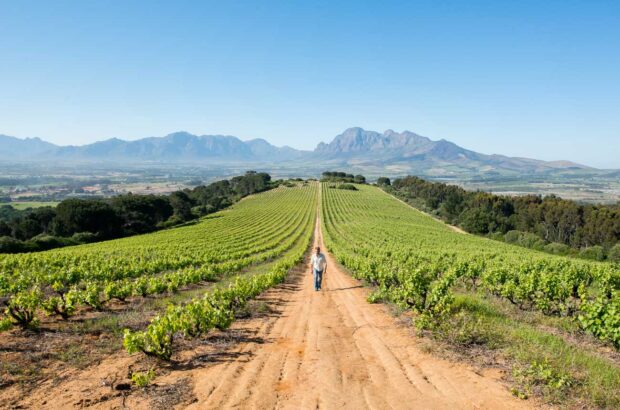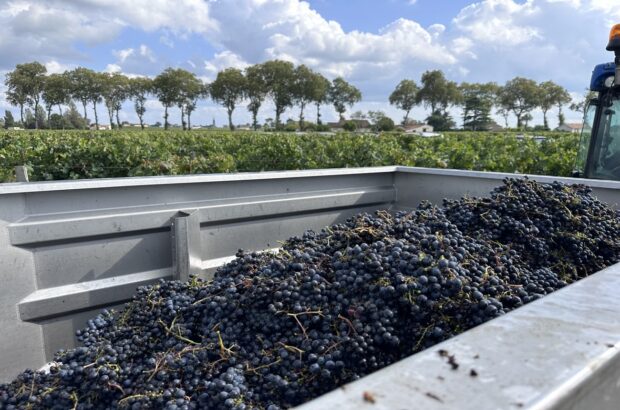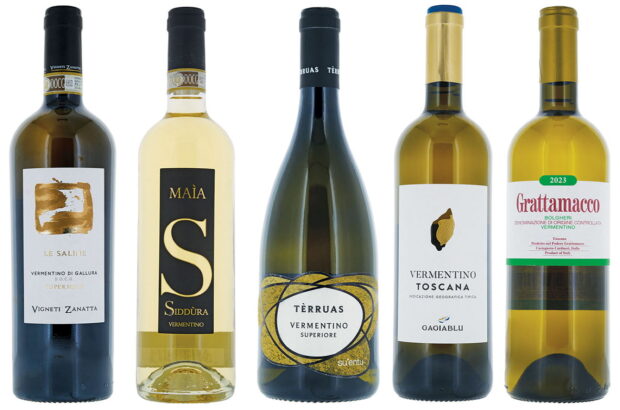The roots of the Pinard family – based in the village of Bué, which lies just over 3km as the bird flies from the town of Sancerre – stretch back over 20 generations to the time of the reign of Henri IV (1553-1610), the first Bourbon king of France.
The first documented mention of their wine-production activities, however, dates from modern times, at the start of the 20th century, referring to Armand Pinard’s ownership of three hectares devoted to polyculture farming but including vine holdings.
Scroll down for 12 Vincent Pinard Sancerre tasting notes and scores
In 1945, Charles Pinard took the reins at the estate in the aftermath of World War II during which the vineyard had greatly suffered.
By the 1960s, he had restored the viability of the family’s wine production through his perseverance, selling and shipping his wines in barrel to Paris.
His legacy continued under the determined impetus of Vincent Pinard and his wife Colette, who were able to expand the family domain after buying the vineyards belonging to cousins in the 1980s and attain its present-day dimension of nearly 17 hectares, while also implementing a renewed style of wine that has become a benchmark for the whole region.
{"content":"PC9wPgo8aDM+PGI+SGFuZHMtb24gdml0aWN1bHR1cmU8L2I+PC9oMz4KPHA+VGhlaXJzIGlzIGEgZGlzdGluY3RpdmUgc3R5bGUgdGhhdCBpcyBib3JuIG9mIGEgbG92ZSBmb3Igd29yayBpbiB0aGUgdmluZXlhcmQgdGhhdCB0YWtlcyBwcmVjZWRlbmNlIG92ZXIgdGhhdCBjYXJyaWVkIG91dCBpbiB0aGUgY2VsbGFyLjwvcD4KPHA+UHJvZHVjdGlvbiB0b2RheSBpcyBpbiB0aGUgaGFuZHMgb2YgVmluY2VudOKAmXMgdHdvIHNvbnMsIENsw6ltZW50IGFuZCBGbG9yZW50LCBoZXJhbGRzIG9mIHRoZSBmYW1pbHkgcGhpbG9zb3BoeSB0aGF0IHRoZSBlc3NlbmNlIG9mIGZpbmUgd2luZSBkZXJpdmVzIGZyb20gbWV0aWN1bG91cyB2aXRpY3VsdHVyZSB1c2luZyBwcmVjaXNlIHNraWxscyBvZiBhIGtpbmQgdGhhdCBhcmUgY29tcGFyYWJsZSB0byB0aG9zZSBvZiBoYXV0ZS1jb3V0dXJlIGZhc2hpb24gcHJvZHVjdGlvbi48L3A+CjxkaXYgY2xhc3M9ImFkLWNvbnRhaW5lciBhZC1jb250YWluZXItLW1vYmlsZSI+PGRpdiBpZD0icG9zdC1pbmxpbmUtMyIgY2xhc3M9ImlwYy1hZHZlcnQiPjwvZGl2PjwvZGl2Pgo8cD5BcyBDbMOpbWVudCBwdXRzIGl0LCDigJg4NSUgb2YgdGhlIHdpbmUgaXMgbWFkZSBpbiB0aGUgdmluZXlhcmQsIHdpdGggdGhlIHJlbWFpbmluZyB3b3JrIGluIHRoZSBjZWxsYXIgYmFzZWQgb24gb2JzZXJ2YXRpb24gYW5kIHNpbXBsZSBsb2dpY+KAmS48L3A+CjxwPlRoZWlyIHdheSBvZiB3b3JraW5nIHRoZSBzb2lsIGlzIG9yZ2FuaWMsIGV2ZW4gYmlvZHluYW1pYywgaW4gaXRzIG9yaWVudGF0aW9uIGJ1dCB0aGUgUGluYXJkcyBkbyBub3Qgd2lzaCB0byBzZWVrIGNlcnRpZmljYXRpb24uPC9wPgo8ZGl2IGNsYXNzPSJhZC1jb250YWluZXIgYWQtY29udGFpbmVyLS1tb2JpbGUiPjxkaXYgaWQ9InBvc3QtaW5saW5lLTQiIGNsYXNzPSJpcGMtYWR2ZXJ0Ij48L2Rpdj48L2Rpdj4KPHA+WWllbGRzIGFyZSBjb250cm9sbGVkIHVzaW5nIHRoZSBQb3Vzc2FyZCBtZXRob2Qgb2YgcHJ1bmluZywgYW4gYWRhcHRhdGlvbiBvZiB0aGUgY2xhc3NpYyBHdXlvdCBwcnVuaW5nIGFwcHJvYWNoIGJ1dCB1c2luZyB0d28gYXJtcyBpbiBhIHdheSB0byBhY2hpZXZlIGEgYmV0dGVyIGJhbGFuY2Ugb2YgdGhlIHZpbmUgdGhyb3VnaCB0aGUgdW5pbXBlZGVkIGZsb3cgb2Ygc2FwLiBUaGlzIGhlbHBzIHRvIGF2b2lkIHRoZSBmb3JtYXRpb24gb2YgZGVhZHdvb2QsIHNvIHN1c2NlcHRpYmxlIHRvIHRoZSBncmFwZXZpbmUgdHJ1bmsgZGlzZWFzZSBrbm93biBhcyBFc2NhLCB3aGljaCBoYXMgYmVjb21lIHdpZGVzcHJlYWQgaW4gRnJlbmNoIHZpbmV5YXJkcywgaW5jbHVkaW5nIHRob3NlIG9mIFNhbmNlcnJlLjwvcD4KPHA+JiM4MjE2O1dlIGFyZSBjYXJlZnVsbHkgZXhhbWluaW5nIHRoZSBiZW5lZml0cyBvZiB1c2luZyB0aGUgbWV0aG9kIG9mIGN1cmV0dGFnZSwgd2hpY2ggaW52b2x2ZXMgY3V0dGluZyBvdXQgYW55IHJvdHRlbiB3b29kLCBhcyBhIHdheSB0byBjb21iYXQgPGEgaHJlZj0iaHR0cHM6Ly93d3cuZGVjYW50ZXIuY29tL3dpbmUtbmV3cy9vcGluaW9uL2plZmZvcmQtb24tbW9uZGF5L2dyYXBldmluZS10cnVuay1kaXNlYXNlLXBoeWxsb3hlcmEtMzgzOTc1LyI+PHN0cm9uZz5Fc2NhPC9zdHJvbmc+PC9hPi4mIzgyMTc7IEl0IGdvZXMgd2l0aG91dCBzYXlpbmcgdGhhdCBpbnNlY3RpY2lkZXMsIHdlZWQga2lsbGVycywgYW5kIGFudGktcm90IHRyZWF0bWVudHMgaGF2ZSBub3QgYmVlbiB1c2VkIGhlcmUgZm9yIGEgbG9uZyB3aGlsZS48c3BhbiBjbGFzcz0iQXBwbGUtY29udmVydGVkLXNwYWNlIj7CoDwvc3Bhbj48L3A+CjxkaXYgY2xhc3M9ImFkLWNvbnRhaW5lciBhZC1jb250YWluZXItLW1vYmlsZSI+PGRpdiBpZD0icG9zdC1pbmxpbmUtNSIgY2xhc3M9ImlwYy1hZHZlcnQiPjwvZGl2PjwvZGl2Pgo8aDM+PGI+SGFuZHMtb2ZmIHdpbmVtYWtpbmc8L2I+PC9oMz4KPHA+QXMgZm9yIHRoZWlyIHdvcmsgaW4gdGhlIGNlbGxhciwgQ2zDqW1lbnQgYmVsaWV2ZXMgdGhhdCBrZWVuIG9ic2VydmF0aW9uIG9mIHRoZSBwcm9jZXNzIGlzIGVzc2VudGlhbCB0byBzdWNjZXNzZnVsIHdpbmVtYWtpbmcuPC9wPgo8cD7igJhXZSBhcmUgbm90IHZlcnkgaW50ZXJ2ZW50aW9uaXN0LiBJdCBhbGwgY29tZXMgZG93biB0byBtYWtpbmcgdGhlIHJpZ2h0IGNob2ljZSBvZiB0aGUgZ3JhcGVzIHRvIHVzZS4gSWYgdGhlIGZydWl0IGlzIGhlYWx0aHksIHRoZXJlIGlzIG5vIG5lZWQgdG8gdXNlIGFueSBhcnRpZmljZXMgZm9yIHRoZSB3aW5lbWFraW5nLuKAmTwvcD4KPHA+Rm9yIHRoZSB3aGl0ZSB3aW5lcywgQ2zDqW1lbnQgUGluYXJkIGFuZCBoaXMgYnJvdGhlciB1c2UgaW5kaWdlbm91cyB5ZWFzdHMgYW5kIGFyZSBrZWVuIG9uIHJlZHVjaW5nIHRoZSBhbW91bnQgb2Ygc3VscGhpdGVzLCB3aGlsZSBhbHNvIGZhdm91cmluZyBiYXJyZWwgYWdlaW5nIHVzaW5nIGNvbmljIGZlcm1lbnRhdGlvbiB2YXRzIG9yIHRoZSA2MDAtbGl0cmUgZm9ybWF0IGtub3duIGFzIGRlbWktbXVpZC4gVGhlaXIgYXZvd2VkIGdvYWwgaXMgdG8g4oCYd29yayB3aXRoIHdvb2Qgd2hpbGUgYXZvaWRpbmcgaXRzIGFyb21hdGljIGluZmx1ZW5jZeKAmS48L3A+CjxwPkZvciB0aGUgcmVkcywgdGhleSB1c2Ugd2hvbGUgYnVuY2hlcyBmb3IgdGhlaXIgc3BlY2lhbCBib3R0bGluZyBuYW1lZCBWZW5kYW5nZXMgRW50acOocmVzLCBidXQgZGVzdGVtbWluZyBpcyB0aGUgcnVsZSBmb3IgdGhlIG90aGVycywgYW5kIHRoZXkgYWxsIGFnZSBpbiAyMjgtbGl0cmUgQnVyZ3VuZHkgYmFycmVscy4gVGhlIGdvYWwsIGFjY29yZGluZyB0byBDbMOpbWVudCwgaXMgZm9yIHRoZSBjb25zdW1lciDigJh0byB0YXN0ZSB0aGUgd29yayBvZiB0aGUgd2luZS1ncm93ZXIgbW9yZSB0aGFuIHRoYXQgb2YgdGhlIGNvb3Blci7igJk8c3BhbiBjbGFzcz0iQXBwbGUtY29udmVydGVkLXNwYWNlIj7CoDwvc3Bhbj48L3A+CjxwPuKAmFdlIGFyZSBjcmFmdHNtZW4sIGFuZCBvdXIgaGFuZGl3b3JrIGlzIGZ1bmRhbWVudGFsIHRvIG91ciBwcm9kdWN0aW9uLOKAmSBoZSBhc3NlcnRzLiBUaGlzIGFwcHJvYWNoIGlzIGFwcGFyZW50IGluIHRoZSB3aW5lcy48L3A+CjxwPlZpbnRhZ2UgYWZ0ZXIgdmludGFnZSwgdGhlIFBpbmFyZCB3aW5lcyBoYXZlIGdhaW5lZCBpbiBwcmVjaXNpb24sIHdpdGggdmVyeSBwdXJlLCByYWN5IGFjaWRpdHksIGFuZCBhcmUgZW1pbmVudGx5IGV4cHJlc3NpdmUgb2YgdGhlIGxpbWVzdG9uZSB0ZXJyb2lycyBvZiBTYW5jZXJyZS48L3A+CjxwPlR3by10aGlyZHMgb2YgdGhlIDE3aGEgZXN0YXRlIGFyZSBwbGFudGVkIHRvIFNhdXZpZ25vbiBCbGFuYywgdGhlIHJlbWFpbmRlciB0byBQaW5vdCBOb2lyLiDigJhXZSBoYXZlIGEgd2lkZSB2YXJpZXR5IG9mIHNvaWxzIGluIFNhbmNlcnJlLOKAmSByZW1hcmtzIENsw6ltZW50LCBhbmQgdGhlIGVzdGF0ZSBvZmZlcnMgMTIgZGlmZmVyZW50IGN1dsOpZXMgcHJvZHVjZWQgZnJvbSBzb21lIDQwIHBsb3RzLjwvcD4KPHA+VGhlIHR5cGUgb2Ygc29pbCAmIzgyMTE7IGJlIGl0IOKAmEtpbW1lcmlkZ2lhbiBvciBPeGZvcmRpYW4gbGltZXN0b25lLCBhIGJpdCBvZiBjbGF5IGFuZCBhIHZlcnkgaGlsbHkgdmluZXlhcmTigJkgJiM4MjExOyB3aWxsIGluZmx1ZW5jZSB0aGUgY2hhcmFjdGVyIG9mIGVhY2ggY3V2w6llLiBUaGUgRmxvcsOocyBjdXbDqWUgcHJvdmlkZXMgYW4gZXhlbXBsYXJ5IGludHJvZHVjdGlvbiB0byB0aGUgUGluYXJkIHN0eWxlLCBjb21iaW5pbmcgcmlnb3VyIGFuZCB2aXZhY2l0eSwgd2hpbGUgR3JhbmQgQ2hlbWFyaW4gaXMgZWxlZ2FudGx5IGV4b3RpYyBidXQganVzdCBhcyB0aWdodGx5IHdvdW5kLjwvcD4KPHA+Q2jDqm5lIE1hcmNoYW5kIGhhcyBhbGwgdGhlIHN0cmVuZ3RoIGFuZCBwb3dlciBvZiBpdHMgbWFnbmlmaWNlbnQgdGVycm9pciB3aGlsZSB0aGUgbW9zdCByZWNlbnQgb2YgYWxsIHRoZSBjdXbDqWVzLCBuYW1lZCBMZSBDaMOidGVhdSwgbWVyaXRzIGNlbGxhcmluZyBmb3IgaXQgdG8gcmV2ZWFsIGl0cyBmdWxsIGNvbXBsZXhpdHkuPC9wPgo8aDM+PGI+VHdvIG91dHN0YW5kaW5nIHZpbnRhZ2VzPC9iPjwvaDM+CjxwPk91ciB0YXN0aW5nIGluY2x1ZGVkIHdpbmVzIGZyb20gdHdvIHJlY2VudCB2aW50YWdlcywgYm90aCBvdXRzdGFuZGluZyBmb3IgdGhlIDxzdHJvbmc+PGEgaHJlZj0iaHR0cHM6Ly93d3cuZGVjYW50ZXIuY29tL3dpbmUvd2luZS1yZWdpb25zL2xvaXJlLyI+TG9pcmUgVmFsbGV5PC9hPjwvc3Ryb25nPiwgMjAxOCBhbmQgMjAxOS48L3A+CjxwPjxzdHJvbmc+MjAxOCA8L3N0cm9uZz48L3A+CjxwPlRoaXMgd2FzIGEgc29sYXIsIG9yIHN1bi1kcmVuY2hlZCwgdmludGFnZSwgYnV0IHRoZSB3aW5lcywgYWNjb3JkaW5nIHRvIENsw6ltZW50LCDigJhkbyBub3QgbGFjayBlbmVyZ3nigJkuPC9wPgo8cD5BZnRlciBhIHZlcnkgZHJ5LCBzdW5ueSBzdW1tZXIsIHRoZSBoYXJ2ZXN0ZWQgZ3JhcGVzIHdlcmUgaW1wZWNjYWJseSByaXBlIGFuZCBoZWFsdGh5LiAyMDE5IHdhcyBhbG1vc3QgaWRlbnRpY2FsIHRvIDIwMTggZHVyaW5nIHRoZSBncm93aW5nIHNlYXNvbiwgYnV0IHRoZSB3aW5lcyBoYXZlIOKAmG1vcmUgdGV4dHVyZeKAmSBhbmQgbW9yZSBmcmVzaG5lc3MgdGhhbiB0aG9zZSBmcm9tIDIwMTguPC9wPgo8cD48c3Ryb25nPjIwMTk8L3N0cm9uZz48L3A+CjxwPkNsw6ltZW50IGNvbmZlc3NlcyB0byBoYXZpbmcgYSBzb2Z0IHNwb3QgZm9yIHRoZSAyMDE5cywgYXMgdGhlIHdpbmVzIGhhdmUgc2hhcnBlciBjb250b3Vycy48L3A+CjxkaXYgY2xhc3M9ImluamVjdGlvbiI+PC9kaXY+CjxwPkFsdGhvdWdoIHRoaXMgdmludGFnZSB3YXMgb3ZlcmFsbCBsZXNzIGhvbW9nZW5lb3VzIHRocm91Z2hvdXQgdGhlIExvaXJlLCB0aGUgYmVzdCB3aW5lcyBoYXZlIHRoZSBzdHJ1Y3R1cmUgdG8gc3RheSB0aGUgZGlzdGFuY2UsIGFuZCBpbiBwYXJ0aWN1bGFyIHRob3NlIG1hZGUgd2l0aCBncmFwZXMgYmVuZWZpdGluZyBmcm9tIGJpb2R5bmFtaWMgZmFybWluZyBoYXZlIHJlbWFya2FibGUgYWNpZGl0eSB0aGF0IHByb3ZpZGVzIGEgd2VsY29tZSBiYWxhbmNlIHRvIHRoZWlyIGlubmF0ZSBwb3dlciBhbmQgZGVuc2l0eS48L3A+CjxwPjxlbT5UaGUgd2luZXMgYXJlIGltcG9ydGVkIGludG8gdGhlIFVLIGJ5IEp1c3RlcmluaSAmYW1wOyBCcm9va3MgYW5kIGludG8gdGhlIFVTIGJ5IExhbmdkb24gU2hpdmVyaWNrIEltcG9ydHMuPC9lbT48L3A+CjxwPgo="}
See the tasting notes and scores for 12 Vincent Pinard Sancerre 2018 & 2019 wines
{}
{"wineId":"47258","displayCase":"standard","paywall":true}
{"wineId":"47257","displayCase":"standard","paywall":true}
{"wineId":"47256","displayCase":"standard","paywall":true}
{"wineId":"47255","displayCase":"standard","paywall":true}
{"wineId":"47254","displayCase":"standard","paywall":true}
{"wineId":"47253","displayCase":"standard","paywall":true}
{"wineId":"47252","displayCase":"standard","paywall":true}
{"wineId":"47251","displayCase":"standard","paywall":true}
{"wineId":"47250","displayCase":"standard","paywall":true}
{"wineId":"47249","displayCase":"standard","paywall":true}
{"wineId":"47248","displayCase":"standard","paywall":true}
{"wineId":"47259","displayCase":"standard","paywall":true}
{}
You might also like:












